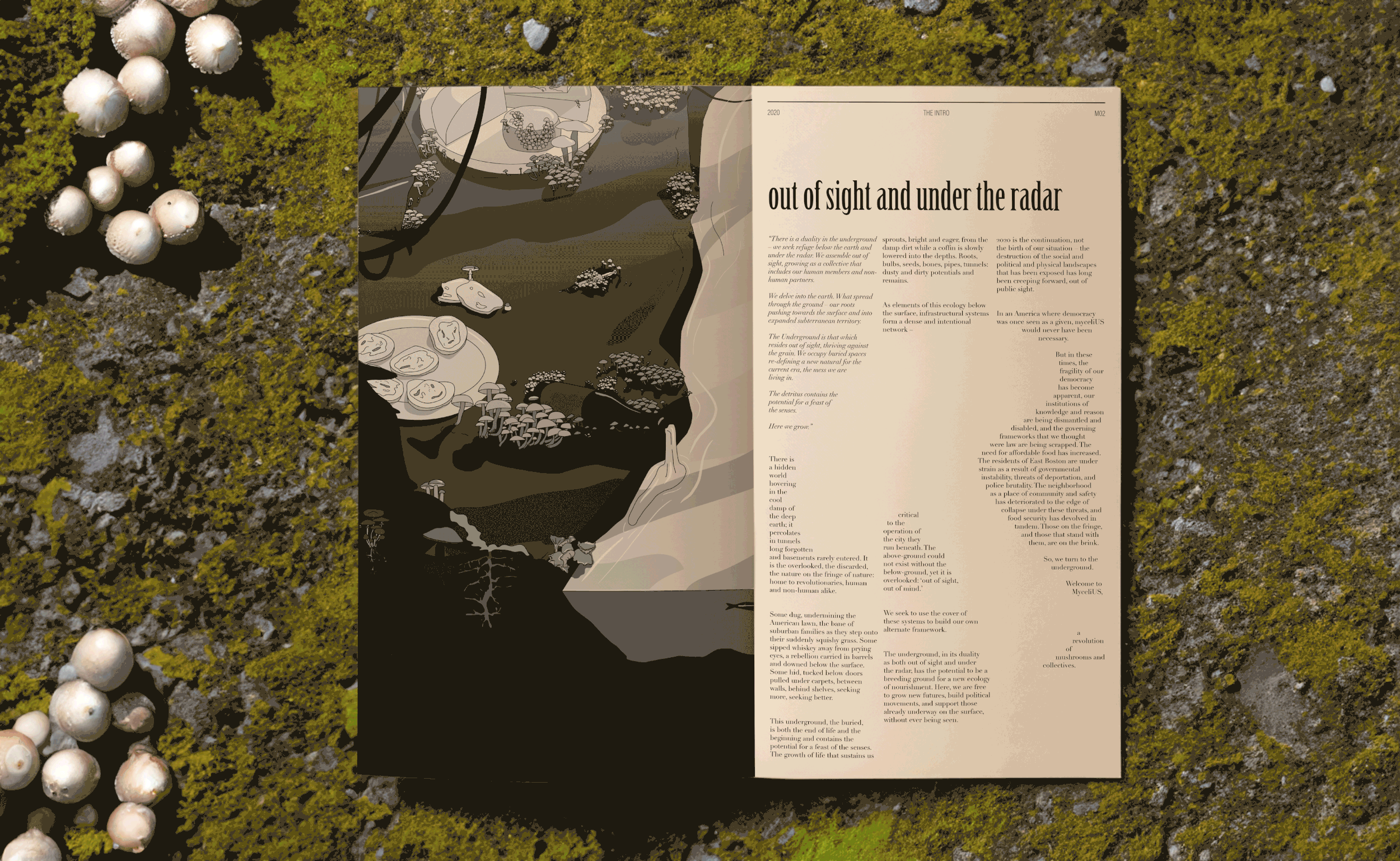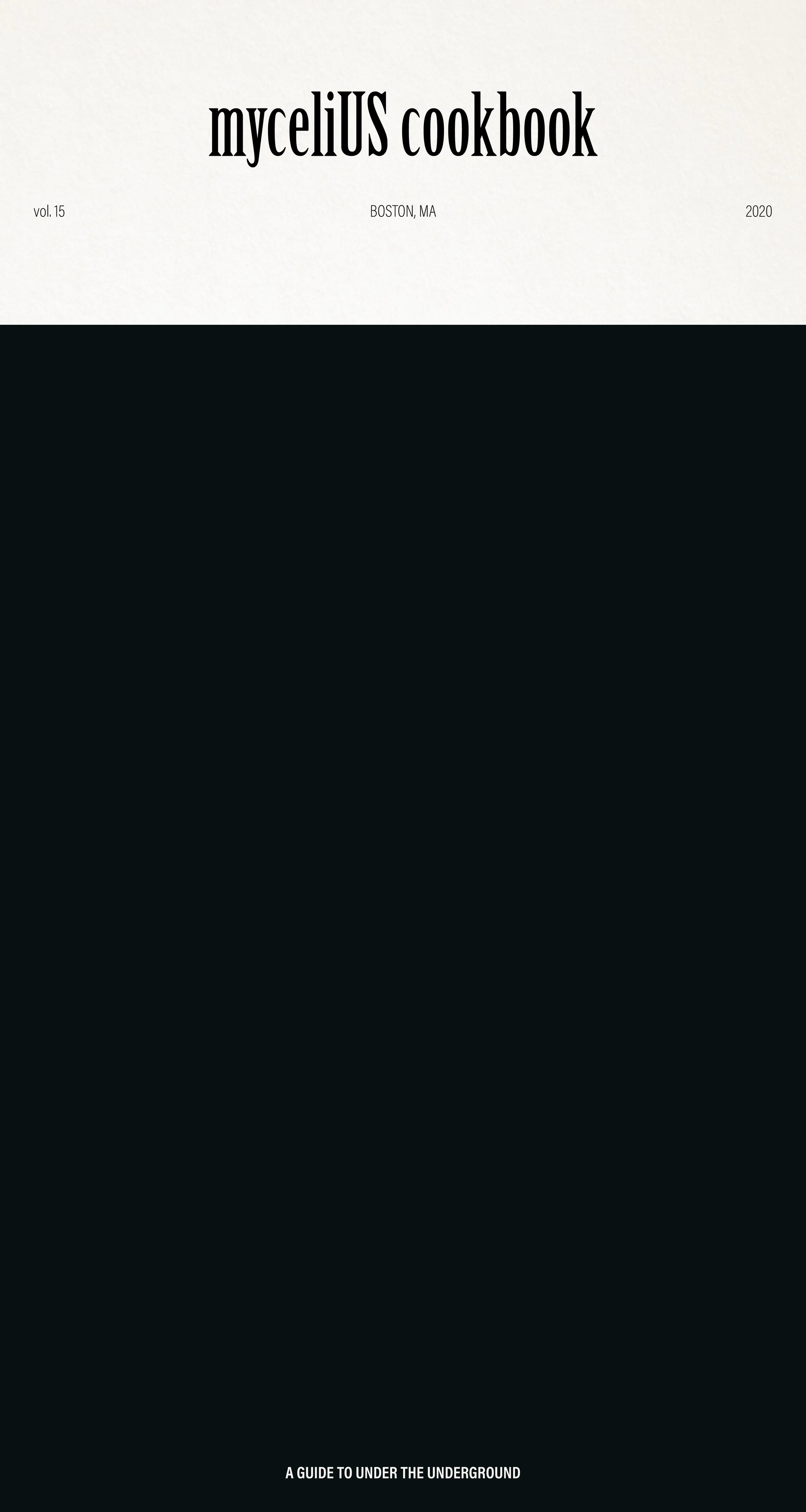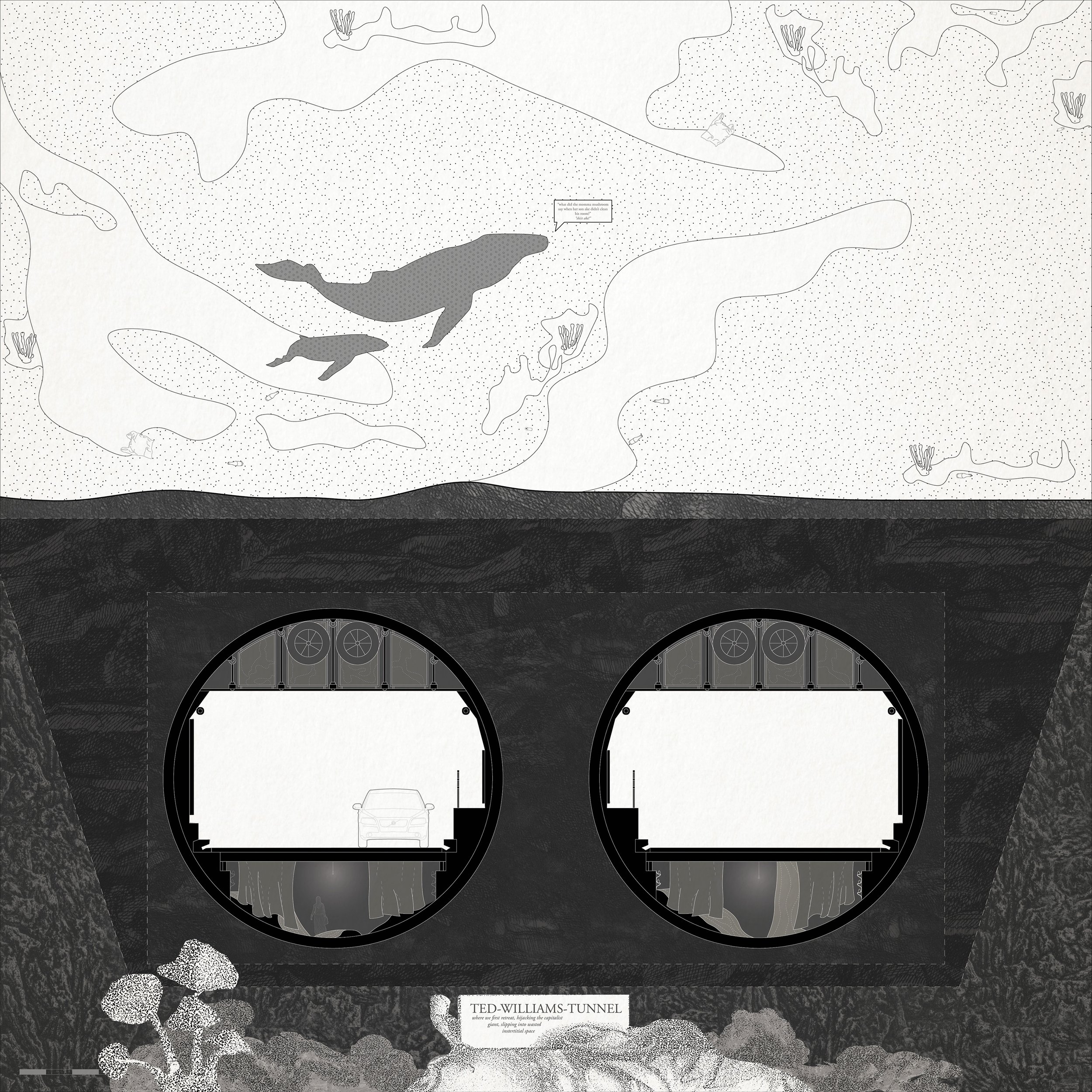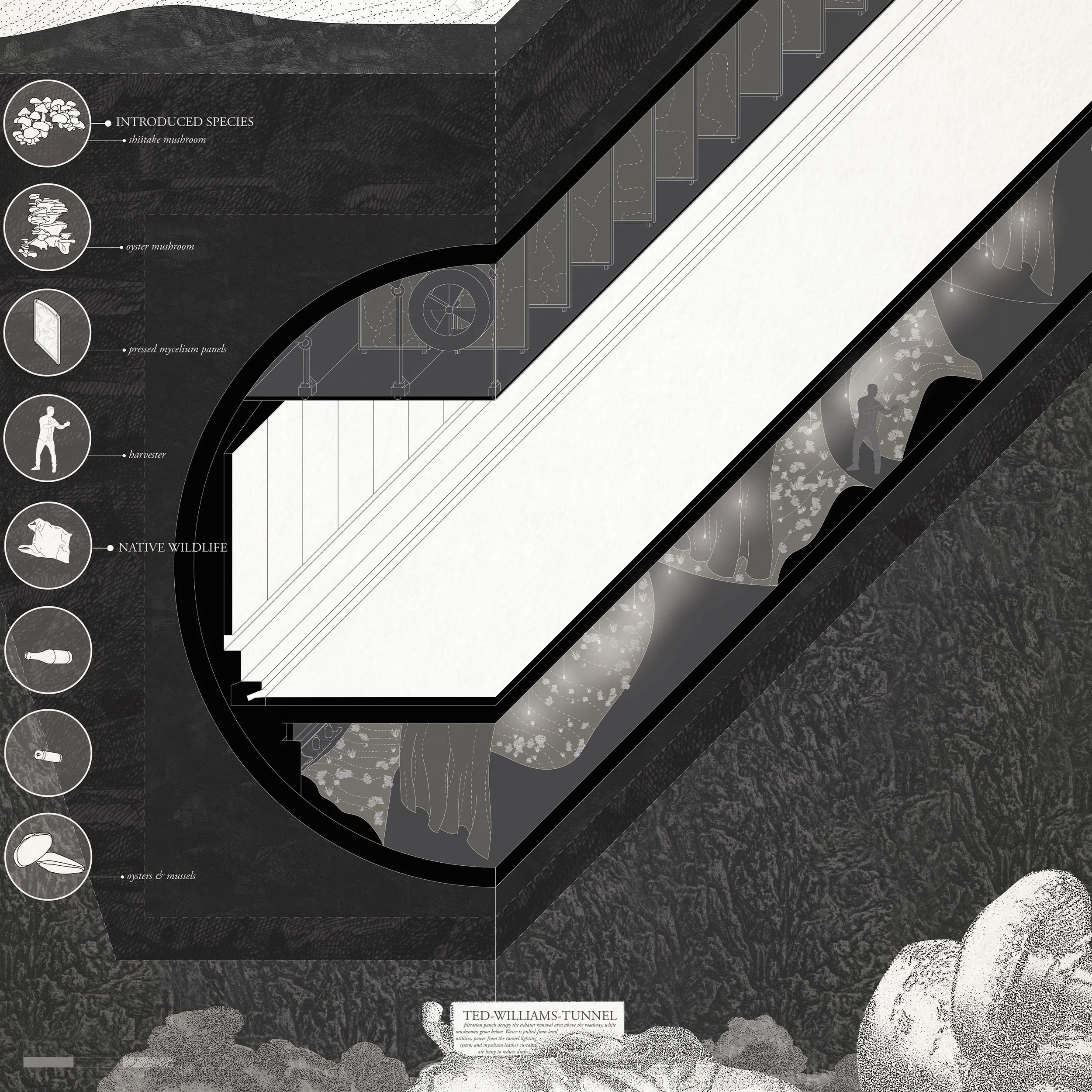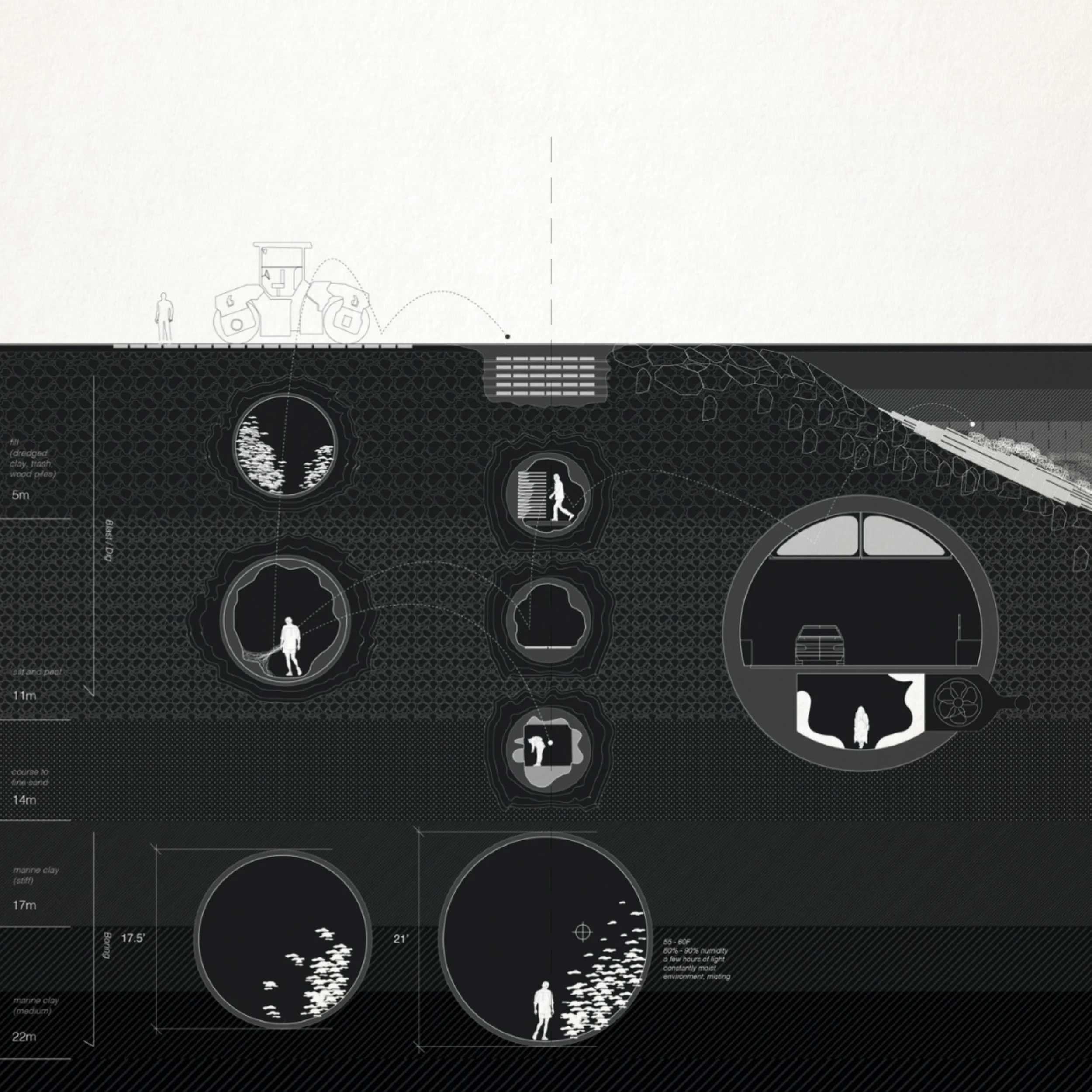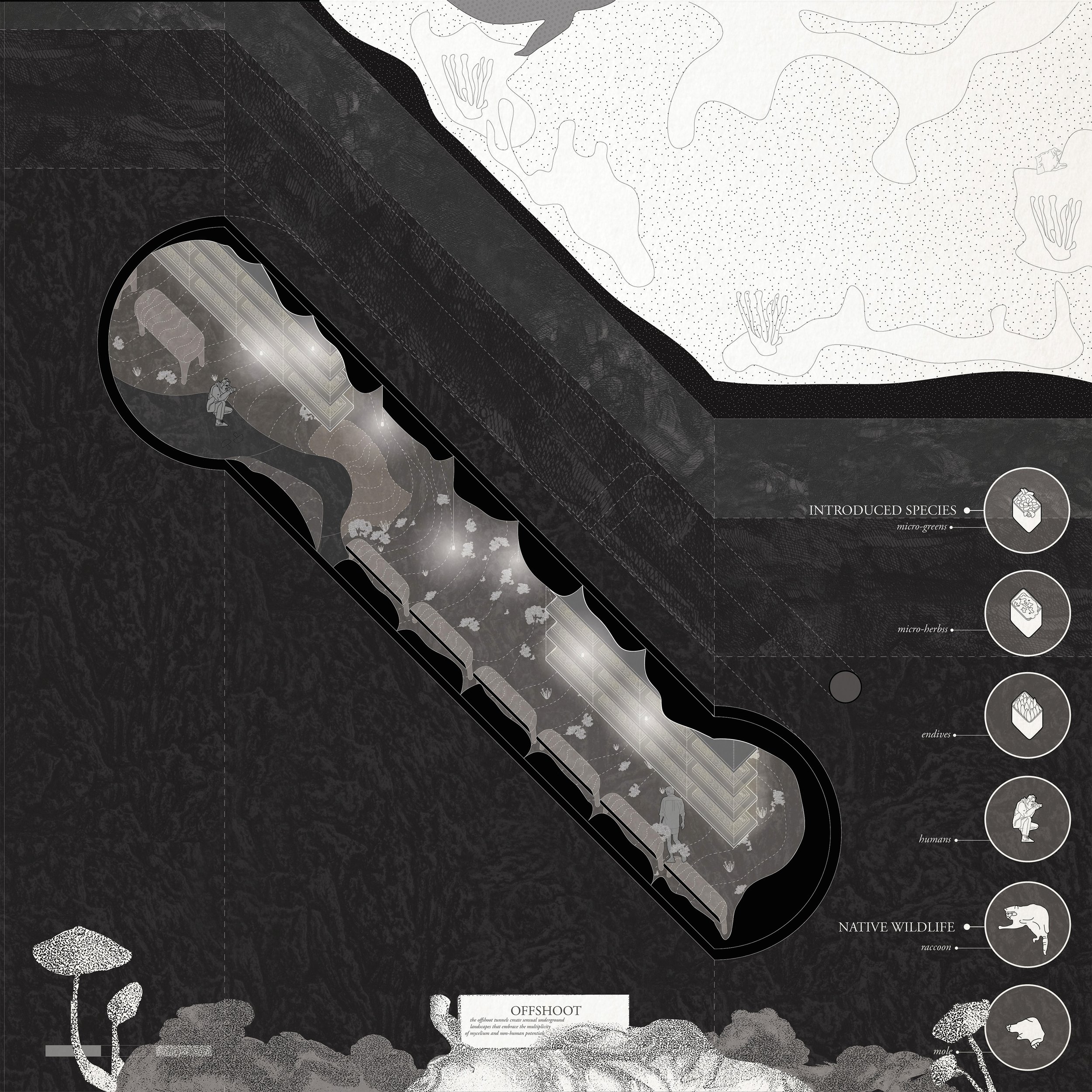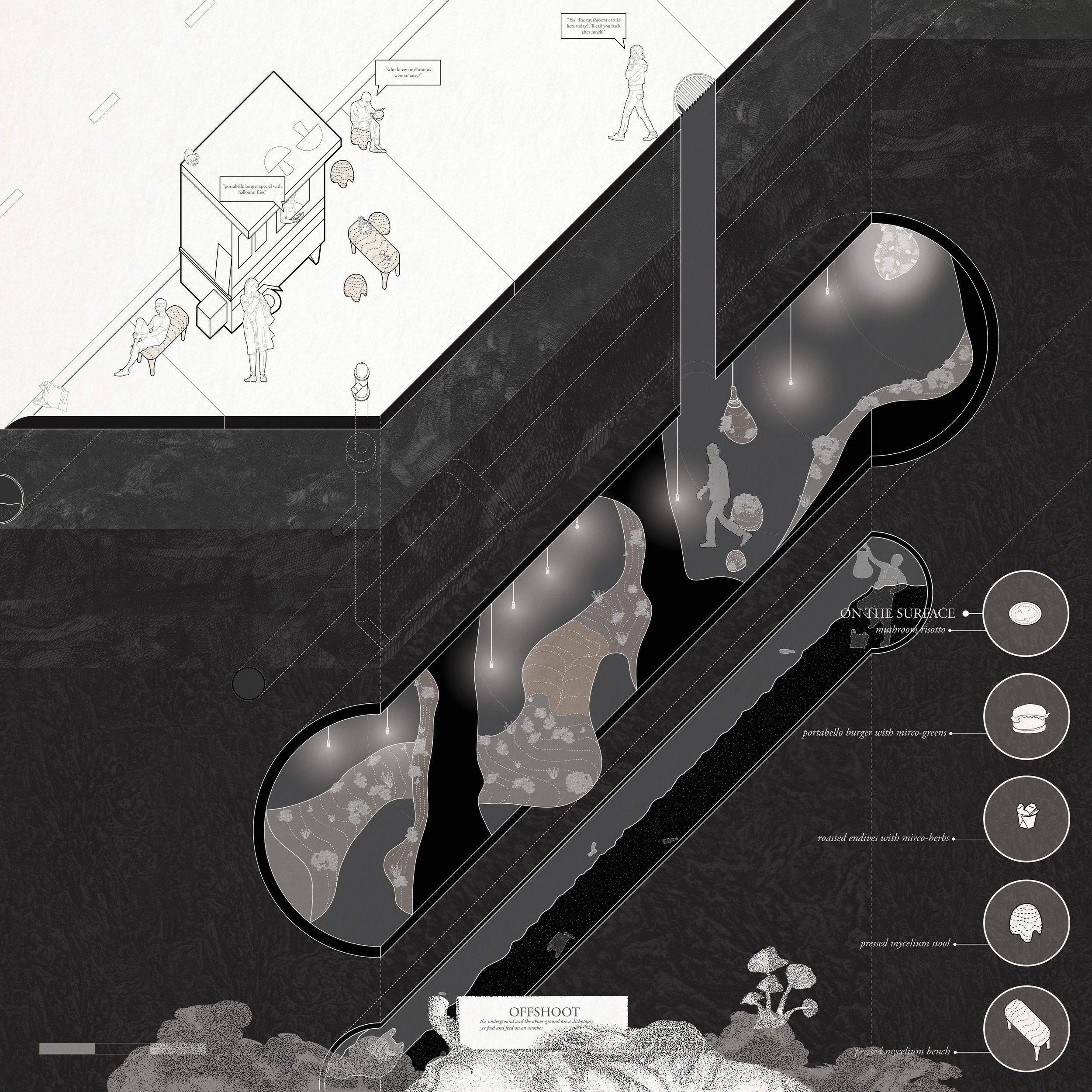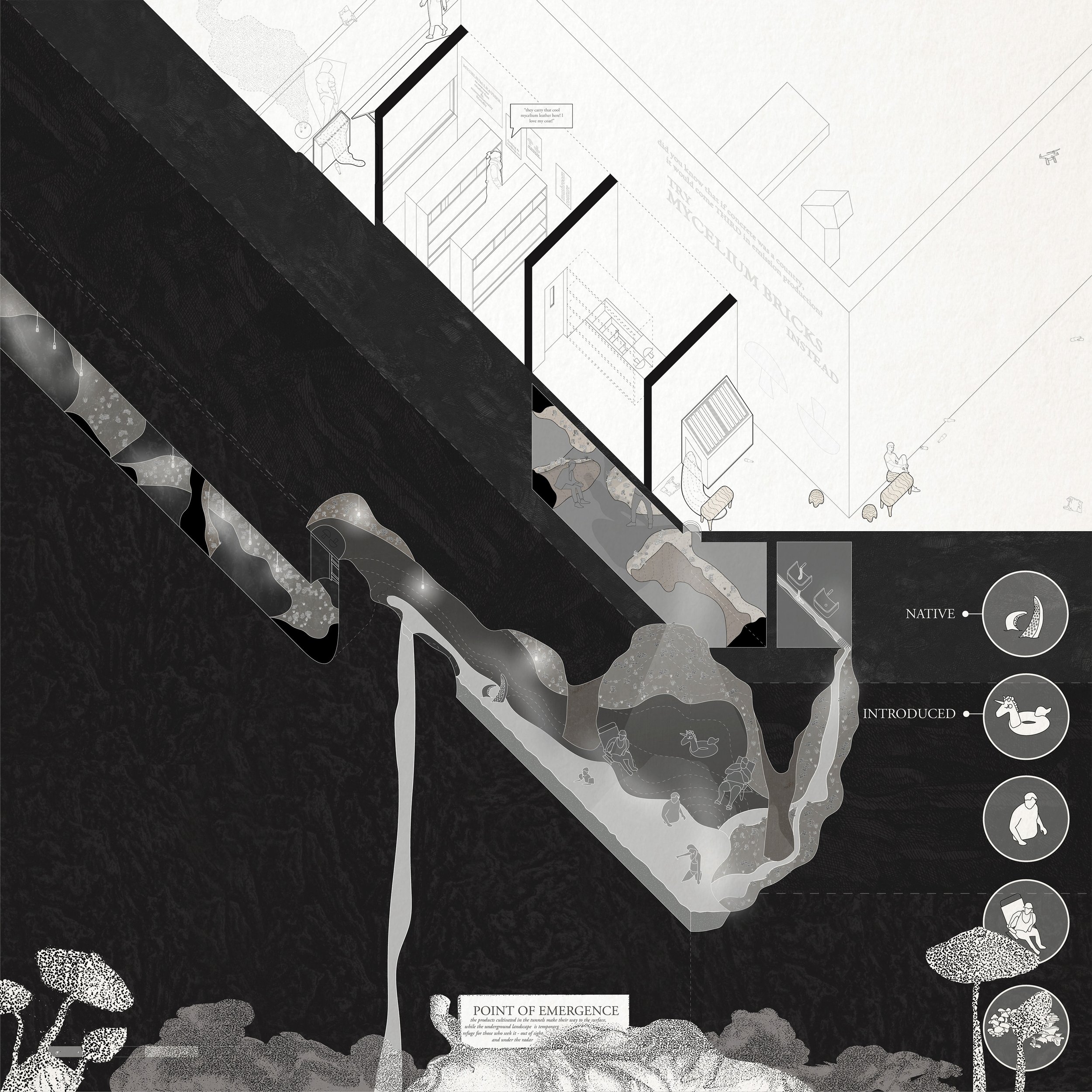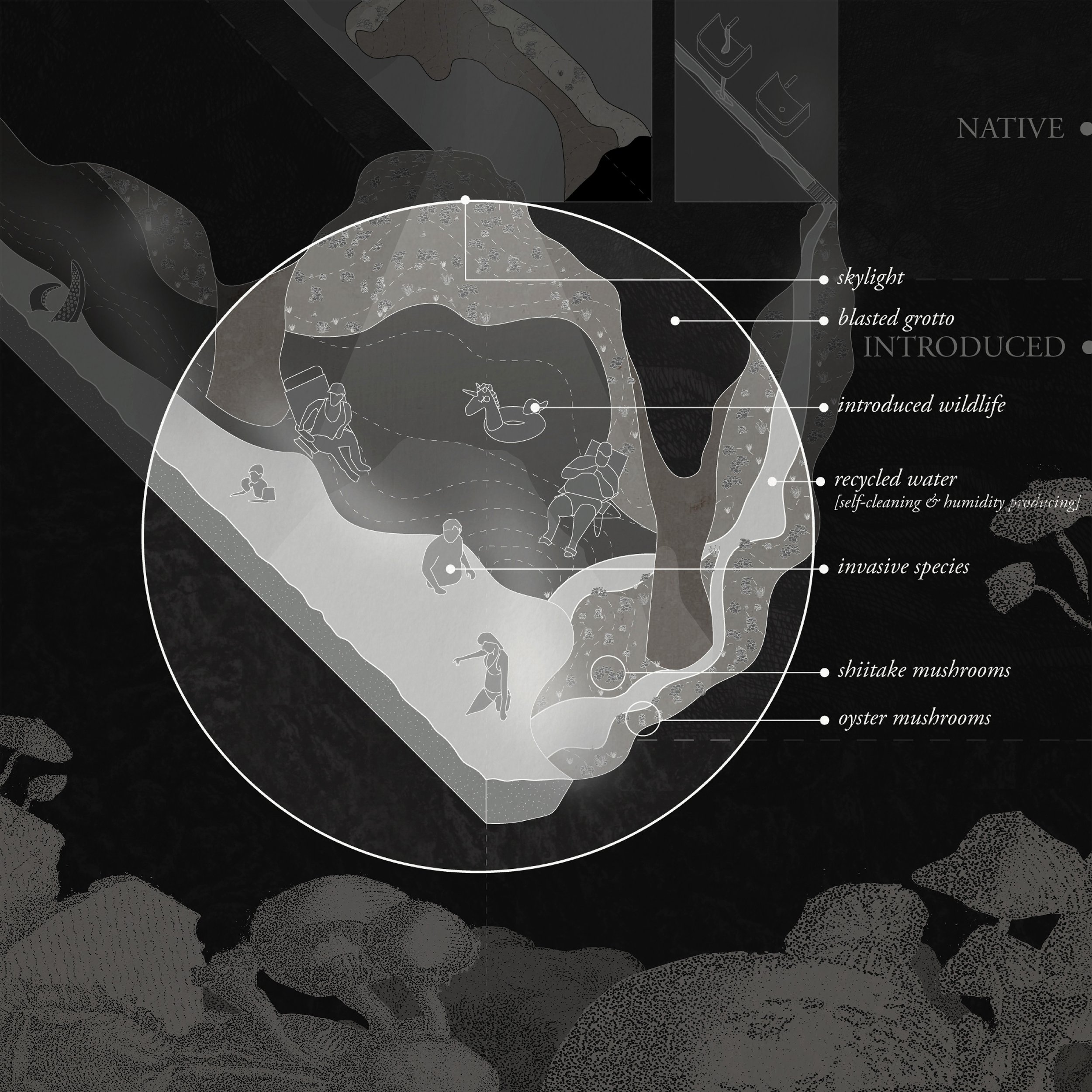myceliUS
an undertaking.- mushrooms aren’t the only thing growing below the surface -
2020 | MIT SA+P | critic: Rania Ghosn | with: Ryan Clement + Angie Door
“There is a duality in the underground – we seek refuge below the earth and under the radar. We assemble out of sight, growing as a collective that includes our human members and non-human partners.
We delve into the earth. What spread through the ground – our roots pushing towards the surface and into expanded subterranean territory.
The Underground is that which resides out of sight, thriving against the grain. We occupy buried spaces re-defining a new natural for the current era, the mess we are living in.
The detritus contains the potential for a feast of the senses.
Here we grow.”
a gif of the internal spreads of the ‘MyceliUS Cookbook’
THE UNDERTAKING
There is a hidden world hovering in the cool damp of the deep earth; it percolates in tunnels long forgotten and basements rarely entered. It is the overlooked, the discarded, the nature on the fringe of nature: home to revolutionaries, human and non-human alike.
Some dug, undermining the American lawn, the bane of suburban families as they step onto their suddenly squishy grass. Some sipped whiskey away from prying eyes, a rebellion carried in barrels and downed below the surface. Some hid, tucked below doors pulled under carpets, between walls, behind shelves, seeking more, seeking better.
This underground, the buried, is both the end of life and the beginning and contains the potential for a feast of the senses. The growth of life that sustains us sprouts, bright and eager, from the damp dirt while a coffin is slowly lowered into the depths. Roots, bulbs, seeds, bones, pipes, tunnels: dusty and dirty potentials and remains.
As elements of this ecology below the surface, infrastructural systems form a dense and intentional network – critical to the operation of the city they run beneath. The above-ground could not exist without the below-ground, yet it is overlooked: ‘out of sight, out of mind.’
We seek to use the cover of these systems to build our own alternate framework.
The underground, in its duality as both out of sight and under the radar, has the potential to be a breeding ground for a new ecology of nourishment. Here, we are free to grow new futures, build political movements, and support those already underway on the surface, without ever being seen.
2020 is the continuation, not the birth of our situation – the destruction of the social and political and physical landscapes that has been exposed has long been creeping forward, out of public sight.
In an America where democracy was once seen as a given, myceliUS would never have been necessary.
But in these times, the fragility of our democracy has become apparent, our institutions of knowledge and reason are being dismantled and disabled, and the governing frameworks that we thought were law are being scrapped. The need for affordable food has increased. The residents of East Boston are under strain as a result of governmental instability, threats of deportation, and police brutality. The neighborhood as a place of community and safety has deteriorated to the edge of collapse under these threats, and food security has devolved in tandem. Those on the fringe, and those that stand with them, are on the brink.
So, we turn to the underground.
Welcome to MyceliUS, a revolution of mushrooms and collectives.
What follows are a series of excerpts from the MyceliUS Cookbook: a grassroots zine that speculates on how to leverage the underground as both an agricultural and social refuge and seed.
THE FRONT AND BACK COVER OF THE ‘MYCELIUS COOKBOOK’
The air intake systems around the Ted-Williams-Tunnel is our critical first artery and testing ground, providing the free land and the damp air needed for mushroom growth.
Into this site we deposit plastic-clad shavings, cultivate spores, and hang lights. We tap into the electrical system of the tunnel itself to power grow bulbs, we siphon water from nearby utilities to mist the crop, and take advantage of the tunnel exhaust circulation for fresh air supply.
A smell of wet dirt and faint exhaust fills the air and the rumble of highway traffic blends to a white noise, the occasional honk echoing off the walls.
THE ARTERY
ted williams tunnel sections
We began using the cover of the ted-williams-tunnel exhaust circulation, growing on the back of the capitalist giant (the most expensive public works project to date).
Yet, even as the market increased, the need for refuge remained. The tunnels expanded – offshoots growing from the connections between tunnels segments, a new landscape across the bottom of the bay.
Some slip into existing tunnels, like abandoned subway routes and out-of-use sewers, others are dug, bored, and blasted.
THE OFFSHOOTS
offshoot construction section
These offshoots make their way towards the city, while providing atmospheres for various species and proximity to the necessary utilities.
While we began with the mushroom and its myriad potentials, we continue to expand our crop to micro-herbs, micro-greens, and endives - companion species to the mycelium that are suited to growth below artificial light surrounded by dank, damp atmospheres. These crops proliferate and expand to fill their new urban landscapes.
THE CROP
offshoot tunnel section, growing the crops
As we expand the network, we connect our tunnels to basements and infrastructure throughout the city. One could emerge from the manhole cover next to city hall or descend through their building’s laundry room.
The mushrooms and crops that are growing below ground slowly begin to infiltrate the city above. They are not only a healthy and affordable alternative food options but are also ecologically friendly - in their method of growing and their potential as biodegradable furniture, fashion, and construction materials.
In MyceliUS, mycelium is not only food, but stool, bench, table, room, and economy. Both feeding and funding the underground.
THE PRODUCT
offshoot tunnel section
offshoot tunnel section - zoom-in
Public spaces have become less welcoming, excluding some from their promise of safe relaxation, yet the underground is only manhole cover or a staircase away.
The mushroom and companion crop growth is a carefully choreographed parasitic invasion. As our crops grow, they take over our tunnels, consume the walls for their nourishment, break down the earth around them, and ultimately ornament and festoon our world.
These mushrooms surround our meeting space. Here we are surrounded by mycelium in its multiplicity, as wall, as room, as seating. Shiitake, oyster, and psychedelic mushrooms alike sprout from the drippy wrinkles of the domes overhead. Water seeping through the earth fills the room, creating underground grotto tide pools. In this new ecosystem, we cultivate a habitat for mussels, clams, their companion creatures, and their predators.
Humans are only one of the many species the space has been designed for.
THE GROTTO
grotto section
Below the ground we embrace the multiplicity of mycelium and non-human potentials, compiling a guide for our cultivators – breaking down how to grow and when to harvest roots and mushrooms.
From its first spores and options of growing methods, to its potential futures as mycelium leeather, furniture, and food.
THE MULTIPLICITY
a breif glimpse into the multiplicity of mycelium
In East Boston, our ideologies and non-human companions mingle with exhaust as they make their way into the city. The growth spills out of our main respiratory connection to the surface, the Ted Williams tunnel exhaust tower.
The once orderly rational architecture is overtaken; symmetry is fractured, and lush fungal ornament overwhelms. This is an architecture of companionship, an architecture where we begin to obliterate the false opposition between nature and humans.
The concrete and steel surfaces that were once inhospitable to growth are now home to organic matter. The ecosystem that was once only comfortable in the underground is now flourishing on the surface. The crevices and grottos formed in this new re-positioned architecture create places for actors who never had an architecture.
Once, only a piece of infrastructure, the Ted Williams exhaust tower now hides queer bars, bathhouses, and breast-feeding booths in its blossoming bulges.
The systems of the surface succumb to the ecosystem of the subterranean. Our revolution has begun.
THE EMERGENCE
conceptual section through the ted williams exhaust tower as traditional architecture begins to be overtaken by the underground
a stack of early zines for distribution
NEXT PROJECT > HARD | SOFT


